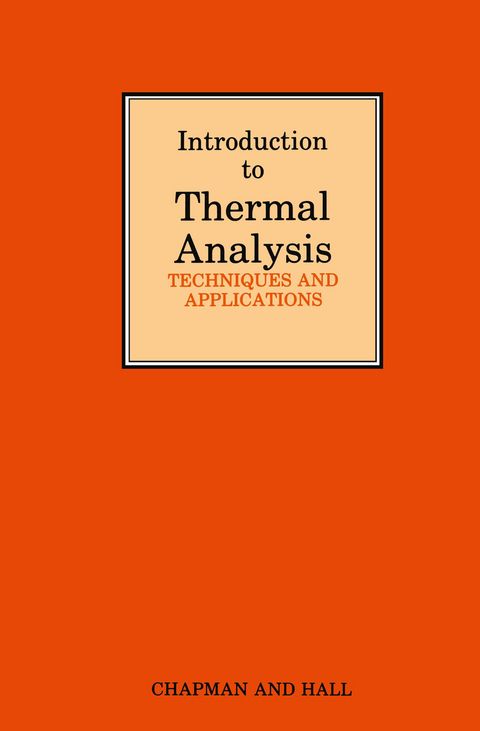
Introduction to Thermal Analysis
Springer (Verlag)
978-94-010-7042-3 (ISBN)
1. Introduction.- 1.1 Definition and history.- 1.2 Thermal analysis instruments.- 1.3 Types of measurement.- 1.4 The main techniques.- 1.5 References.- 2. Thermal events.- 2.1 Reactions of solids.- 2.2 References.- 3. Thermogravimetry (TG).- 3.1 Introduction.- 3.2 The balance.- 3.3 Heating the sample.- 3.4 The atmosphere.- 3.5 The sample.- 3.6 Temperature measurement and calibration.- 3 7 Temperature programmers.- 3.8 Interpretation of TG and DTG curves.- 3.9 Applications of TG.- 3.10 References.- 4. Differential thermal analysis (DTA) and differential scanning calorimetry (DSC).- 4.1 Classical DTA.- 4.2 Calorimetric DTA or heat-flux DSC.- 4.3 Differential scanning calorimetry (DSC).- 4.4 Comparison of the principles of DTA and DSC.- 4.5 Sample containers and sampling.- 4.6 Quantitative aspects of DTA and DSC curves.- 4.7 Interpretation of DTA and DSC curves.- 4.8 Measurement of heat capacity.- 4.9 Measurement of thermal conductivity.- 4.10 Determination of phase diagrams.- 4.11 General applications of DTA and DSC.- 4.12 References.- 5. Thermoptometry (TD).- 5.1 Introduction.- 5.2 Thermomicroscopy.- 5.3 Thermophotometry.- 5.4 Thermoluminescence.- 5.5 Electron microscopy.- 5.6 References.- 6. Thermodilatometry (TD).- 6.1 Basic principles.- 6.2 Practical details.- 6.3 Interpretation of results.- 6.4 Applications of thermodilatometry.- 6.5 References.- 7. Thermomechanical analysis (TMA).- 7.1 Basic principles.- 7.2 Practical details.- 7.3 Applications of TMA.- 7.4 References.- 8. Dynamic mechanical analysis (DMA) or dynamic thermomechanometry.- 8.1 Basic principles.- 8.2 Applications of DMA.- 8.3 References.- 9. Combination of thermal analysis techniques.- 9.1 Principles.- 9.2 References.- 10. Evolved gas analysis (EGA).- 10.1 Basic principles.- 10.2 Evolved gas detection(EGD).- 10.3 Evolved gas analysis (EGA).- 10.4 Applications of EGD and EGA.- 10.5 References.- 11. Less-common techniques.- 11.1 Emanation thermal analysis (ETA).- 11.2 Thermomagnetometry (TM).- 11.3 Thermoelectrometry.- 11.4 Thermosonimetry (TS) and thermoacoustimetry.- 11.5 References.- 12. The use of microcomputers in thermal analysis.- 12.1 Introduction.- 12.2 Hardware requirements.- 12.3 Software requirements.- 12.4 Data storage.- 12.5 Data processing.- 12.6 Additional benefits.- 12.7 Automation of thermal analysis equipment.- 12.8 References.- 13. Reaction kinetics from thermal analysis.- 13.1 Introduction.- 13.2 Heterogeneous reactions.- 13.3 Formulation of the problem.- 13.4 Differential methods.- 13.5 Integral methods.- 13.6 The influences of various parameters on the shapes of theoretical thermal analysis curves.- 13.7 Conclusion.- 13.8 References.- 14. Purity determination using DSC.- 14.1 Introduction.- 14.2 Phase equilibria.- 14.3 The DSC melting curve.- 14.4 Corrections.- 14.5 Step methods.- 14.6 Conclusions.- 14.7 References.- 15. The literature and nomenclature of thermal analysis.- 15.1 Books.- 15.2 Reviews.- 15.3 Conference proceedings.- 15.4 Journals.- 15.5 Manufacturer’s literature.- 15.6 The nomenclature of thermal analysis.- 16. Thermal analysis equipment.- 16.1 Choosing thermal analysis equipment.- 16.2 Major suppliers of thermal analysis equipment.- 17. Conclusion.- Appendix A. Introductory experiments in thermal analysis.- A.1 Differential scanning calorimetry (DSC).- A.2 Thermogravimetry (TG).- Appendix B. Thermal analysis software.- B.1,2 Data capture and storage.- B.3 Display of data.- B.4 Modification of the data.- B.5 Processing of the data.- Appendix C. Explanation of the symbols used in the text.
| Zusatzinfo | 224 p. |
|---|---|
| Verlagsort | Dordrecht |
| Sprache | englisch |
| Maße | 155 x 235 mm |
| Themenwelt | Naturwissenschaften ► Chemie ► Analytische Chemie |
| Naturwissenschaften ► Chemie ► Anorganische Chemie | |
| Naturwissenschaften ► Chemie ► Organische Chemie | |
| Naturwissenschaften ► Chemie ► Physikalische Chemie | |
| Technik ► Maschinenbau | |
| ISBN-10 | 94-010-7042-3 / 9401070423 |
| ISBN-13 | 978-94-010-7042-3 / 9789401070423 |
| Zustand | Neuware |
| Haben Sie eine Frage zum Produkt? |
aus dem Bereich


